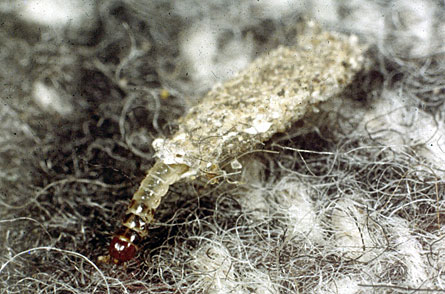Caterpillars tattletale to police
Clothes moth larvae snack on hair from corpses, providing police with genetic clues
By Tia Ghose
 |
|
A casemaking clothes moth caterpillar crawls around partly surrounded by its long, lumpy case. Now scientists have found a caterpillar case (not this one) that incorporated hair from a nearby abandoned human body. Using the DNA in the hair can help investigators identify the body.
|
| Clemson University/USDA Cooperative Extension Slide Series, Bugwood.org |
Clothes moth caterpillars may be a nuisance for your wardrobe, munching holes through sweaters and socks. But the pests don’t just eat clothing, they also feast on human hair. And though that may not sound as tasty as a glass of milk and cookies, the insects’ ghoulish appetite could help detectives who want to identify dead bodies.
Just like butterflies, casemaking clothes moths, Tinea pellionella, start as caterpillars. They transform to their moth namesake later in life. These insects are known best for the holes they leave in wool garments. But scientists have known that clothes moths also dine on dead animals in the wild, according to entomologist Sybil Bucheli of Sam Houston State University in Huntsville, Texas. “They had to eat something before people invented wool sweaters,” Bucheli said.
Now, though, Bucheli is showing how to use the moths’ leftovers as a forensic tool to solve mysteries. Little stubs of hair chewed up by a clothes moth caterpillar contain enough DNA, or genetic material, to identify the person the hair came from. That can help police sleuth out the identity of dead bodies, or even figure out where a person died.
To keep cozy and safe, the clothes moth caterpillar builds itself a case of woolly fibers and hair. The caterpillar burrows inside the case, dragging it around while feeding. The insect pokes its front end out to eat, growing bigger by the day. To adjust, the caterpillar expands its case with snips of hair and fiber found along the way.
Once it’s time to change into a moth, the caterpillar shuffles off into an out-of-the-way place and sheds the woolly case. The new moth may fly away, but it leaves its cast-off case behind.
And that’s precisely what forensic scientists could use to put a name to a dead body. These cases have enough bits of DNA-carrying hair that police can determine the identity of the person the hair belongs to — even if the person’s body gets moved to another location, away from the caterpillar’s case.
Already, the moths have showed their worth in a real case. They collected enough hair for DNA testing from an unlucky person found dead in Galveston County, Texas in 2007, Bucheli said.







